The Angelbird Wings PX1 M.2 Adapter Review: Do M.2 SSDs Need Heatsinks?
by Billy Tallis on December 21, 2015 8:00 AM ESTSequential Write
Sequential writes are easier for the SSD controller to process than random writes, so throughput is almost always higher and the bottleneck in this test shifts more to the flash itself. This test puts the most intense load on the flash out of any of our tests, and usually produces the highest overall power consumption. The timing of the sub-tests is the same as for the random tests, and the drive is filled before the test so that features like SLC write caching don't distort the beginning of the test.
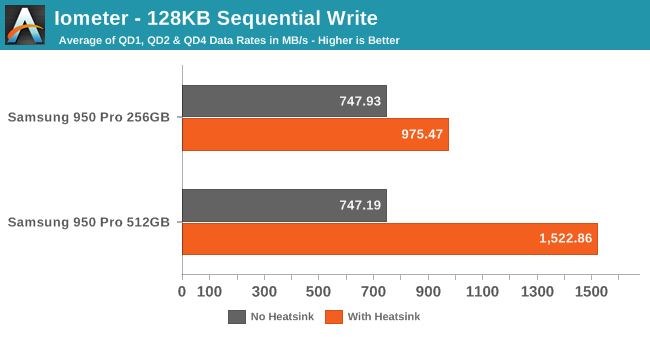
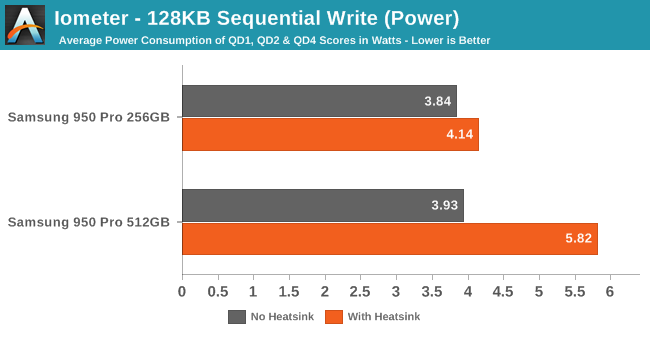
The heatsink provides a nice boost to the 256GB 950 Pro's sequential write speed, but doubles the sustained performance of the 512GB model. Power efficiency is still improved, especially for the 512GB drive, but it's now reaching almost 6W.
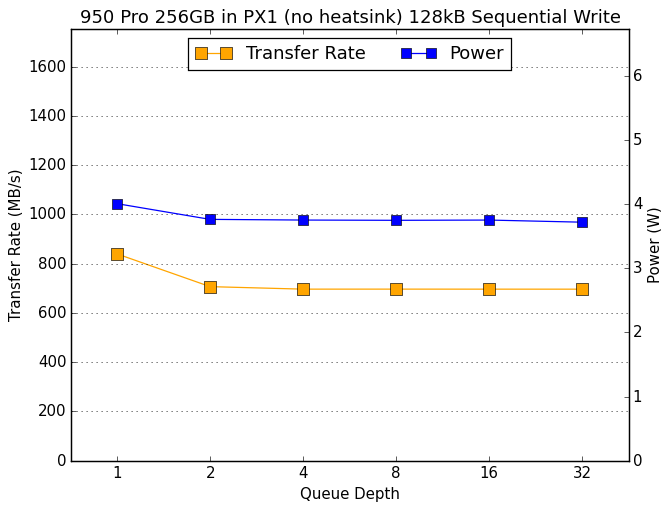 |
|||||||||
| 256GB no heatsink | 512GB no heatsink | ||||||||
| 256GB with heatsink | 512GB with heatsink | ||||||||
Without the heatsink, both drives experience thermal throttling only a few minutes into the test, with QD2 performance lower than QD1. With the heatsink, both drives show steady performance across the entire test. The 256GB improves QD1 performance slightly while the 512GB drive sees a 73% increase in QD1 performance. At queue depths greater than one the performance improvements are even larger.
Sequential Read
With the lower overhead of sequential operations and the inherent speed advantage reads have over writes, the sequential read test usually produces the highest throughput numbers. For SATA drives nowadays this usually means the SATA interface itself is the bottleneck, but even with NVMe we haven't seen a drive yet saturate the bandwidth of a PCIe 3.0 x4 link. Depending on the drive, this test could be limited by bottlenecks in the SSD controller's host interface or its connections to the flash memory.
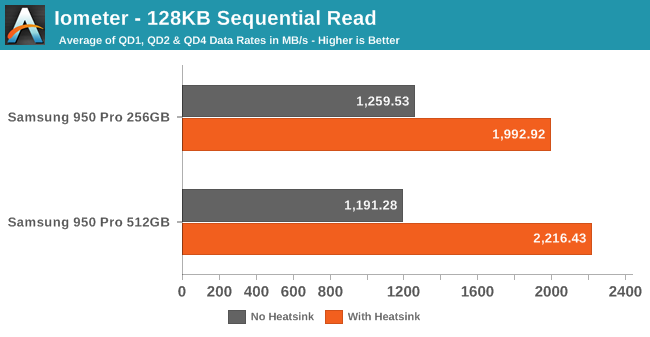

Both capacities see significant gains in sequential read performance, accompanied by smaller but still significant increases in power consumption. The 512GB drive once again manages to double sustained performance, and the 256GB improves by 58%.
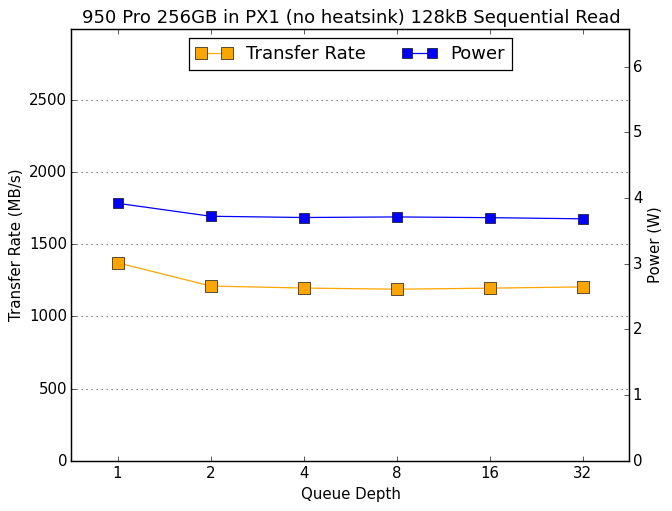 |
|||||||||
| 256GB no heatsink | 512GB no heatsink | ||||||||
| 256GB with heatsink | 512GB with heatsink | ||||||||
Again we see that the drives can't scale with higher queue depths when they're thermally constrained, but when properly cooled they perform superbly with any queue depth larger than one. The 512GB drive manages to deliver slightly more than 2.6GB/s read speed, well above what can be achieved with PCIe 2.0 x4 and about two thirds of the capacity of the PCIe 3.0 x4 link used by the 950 Pro.










69 Comments
View All Comments
RealBeast - Monday, December 28, 2015 - link
"You know, since the LED's are white" Not really.Tell the Nobel committee about it. The 2014 prize in physics went to the blue boys -- red and green had been around for a while, and only they made white possible: http://www.nobelprize.org/nobel_prizes/physics/lau...
h4rm0ny - Tuesday, December 22, 2015 - link
Whilst agreeing with your point, you want either 'irrespective' or 'regardless', not "irregardless".More on topic I agree with both of you - I both recognize that what Teizo says about the customer base is probably true, and also agree with mooninite's despair that this is so. The two posts are not incompatible.
Murloc - Tuesday, December 22, 2015 - link
-less = withoutir- = in- before an 'r', the same as English un- (in- is latin, un- is germanic), it has a negative or privative force.
pick one but not both.
That said, RGB LEDs would make it cost too much, the price is already too high for consumers.
ddriver - Monday, December 21, 2015 - link
DO'H, it is not rocket science, if it overheads and throttles back as a result, then it obviously needs a heat sink.bug77 - Monday, December 21, 2015 - link
I think these tests answer another important question: when does it overheat.As it is, the drives only overheat during sustained write. This is far from unexpected, but at the same time it is reassuring to know it is the only scenario where a drive would throttle (as opposed to throttling under regular desktop usage).
ddriver - Monday, December 21, 2015 - link
But what about another important question, how much does it "hurt" to add a dollar worth of aluminum to improve a product worth several hundred dollars?bug77 - Monday, December 21, 2015 - link
If you have ever installed an M.2 drive, then you know there's not much space left for a heatsink. And you can only install it on one side. Even so, it's so close to the motherboard (and usually between PCIe slots) that if you don't have a hell of an airflow, it won't make much difference anyway.And that's only for desktops, good luck trying to fit a M.2 drive with a heatsink attached into an ultrabook.
ddriver - Monday, December 21, 2015 - link
You are very limited conceptually - it doesn't have to be a "radiator" type of heatsink, a flat piece of aluminum 2-3 mm thick would suffice. Heatsinks come in various shapes and sizes, not necessary the bulky, thick finned design.The SSD doesn't displace a lot of heat to begin with, but without a heatsink for that HEAT to SINK into the bare chip quickly runs out of thermal room.
Even if it still throttles, it will ramp the temp up slower as the heatsink will act as a buffer, and regardless of how little airflow it may have, a larger piece of aluminum will always displace much more heat than a tiny chip.
It will be slower to overheat and faster to cool, even in an ultrabook or tablet, and yes, with the kind of heatsink it merits it will have no trouble fitting into portable devices.
Judging by the performance regressions from adding a heatsink to the larger model, it would seem that engineers were well aware it throttles and have optimized the product for it, so taking care of the heat puts the device in a less than optimal standing. A firmware update should be enough to address this issue and eliminate any sort of performance regressions and actually improve it somewhat. Engineering a product which runs worse with better cooling - that's kind of an epic fail.
jjj - Monday, December 21, 2015 - link
Unless it detects benchmarks and lets the controller clock higher for better scores.If VW can do it , the possibility needs to be investigated elsewhere too.nathanddrews - Monday, December 21, 2015 - link
You know what this means, right? Next test: custom water blocks.